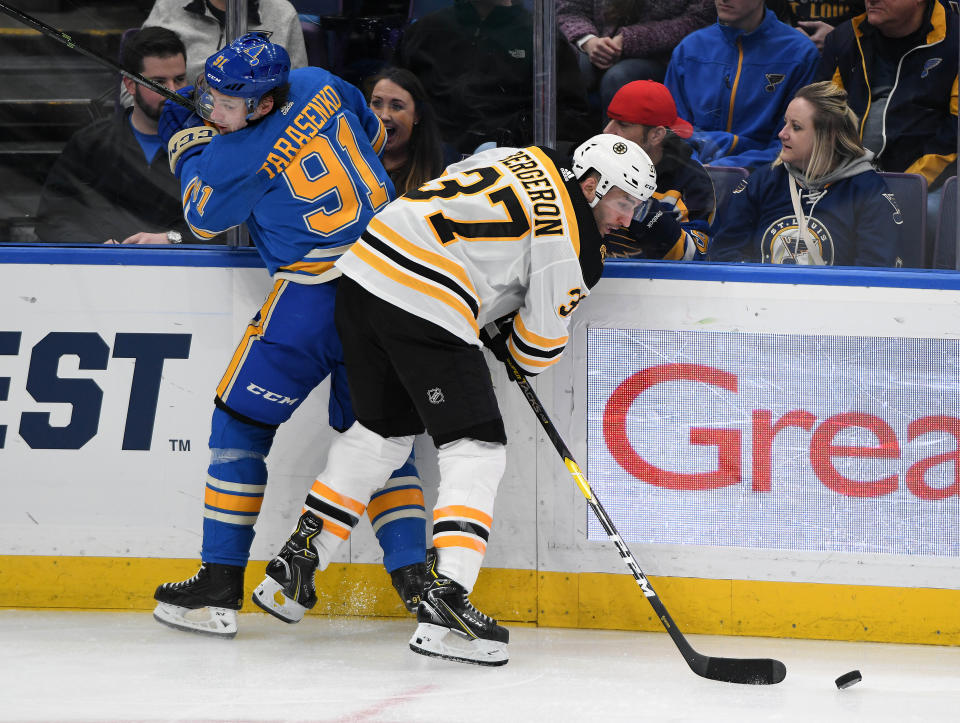The Blues and Bruins aren’t in the Cup Final because they’re physical

The takeaway for both teams that got bounced in the Conference Finals was, apparently, that they lost because they couldn’t stand up to the physical play of the other side.
Which is a weird conclusion to draw when you lose in a sweep 17-5 on aggregate, or in six games 23-15, including 12-2 in the last three.
Here’s Pete DeBoer after his team’s 5-1 loss in Game 6, for which three of the team’s five best players were not available:
DeBoer: "The 2 hardest, heaviest teams are in the Final. Everybody talks about skill & speed, there's room for all these small players. There is a room for that. But I don't think it's an accident.
"There was no space. They're heavy, hard & organized. There wasn't any room."— Sheng Peng (@Sheng_Peng) May 22, 2019
Just a note on the lack of availability for Erik Karlsson, Joe Pavelski, and Tomas Hertl: Only Pavelski’s injury was a result of the Blues’ physicality. He got crunched along the boards by Alex Pietrangelo. But Karlsson was working on a wonky groin for most of the season, and Hertl was knocked out by a headshot Ivan Barbashev, away from the play, which is where we have to draw a distinction between “physical” and “dirty.” That hit was the latter.
And really, they were more than holding their own in the series until Karlsson was clearly in great pain in Game 4. Now, maybe the hits he absorbed throughout the playoffs caught up to him, and that’s a cumulative thing, but there’s no universe in which you would describe Karlsson as a physical player and yet he was the engine for much of the Sharks’ offensive and defensive success.
Meanwhile, the feeling in Raleigh — at least among the local media — is that the Hurricanes were at a disadvantage throughout the entire playoff because of a lack of physicality. The team took more hits than it doled out, you see, and that’s a problem.
I would argue the bigger problem for this team that swept its way through the second round and unseated the reigning Cup winners in the first, was that it ran into a goalie with a .940-plus save percentage. And for that matter, the Sharks got .869 goaltending from Martin Jones in the Conference Final, which doesn’t seem like an issue of lacking physicality. Nor does the Blues’ power play going 5-for-15 in Games 3 through 6.
(Worth noting, too, that the Blues weren’t even that good in the postseason leading up to Game 4, when Karlsson finally faltered: They’d been outscored 46-45 in all situations in their previous 16 games. They just ran away with it when the Sharks’ injuries and poor goaltending gave them the opportunity. That’s what good teams do.)
People think of the Bruins as being physical but one must understand that the local media constantly criticized them this year for not being physical enough. Consider who their best outfield players are: Bergeron, Marchand, Pastrnak, Krejci, McAvoy, Krug, Chara. Only the last of these falls into the realm of physical and oh by the way he’s 100 years old and he’s looked it for most of this playoff run. We must also delineate Marchand as being “dirty” rather than “physical,” at least by reputation.
Same goes for St. Louis. You don’t think of Vladimir Tarasenko or Jaden Schwartz, who scored the bulk of the Blues’ goals in the back half of that last series, as being physical players. Same for Ryan O’Reilly and Brayden Schenn. Pietrangelo may have injured Pavelski on a clean check, but he was credited with just 62 hits this season.
What you have to understand is that these are all very good players who do not shy away from contact. This does not make them “hard” or “heavy,” it just means they are really good players who play with an edge, for very good coaches who have implemented systems that allow them to succeed based on their extant skills. That’s not to say there aren’t more physical players on their rosters, obviously, but those guys aren’t the difference-makers.
The giveaway in DeBoer’s quote above is pretty clear to me: “There was no space. They’re heavy, hard, and organized.” The Blues are, it must be said, one of the tallest and heaviest teams in the league, but the Bruins are in the bottom 10 in both categories, slightly below average. The average Shark is about three pounds lighter and a third of an inch shorter than the average Blue. Tough to imagine that’s what made the difference here.
So why are Boston and St. Louis so good at providing their opponents “no space?” Because they’re “organized.” It’s a very simple concept, so simple that I guess otherwise smart hockey people attribute it to stuff they should know isn’t the reason their teams lost.
The NHL is a copycat league, they say, and perhaps the league broadly agrees that the Blues and Bruins got this far because of their physicality, rather than the skill they possess both throughout the lineup and behind the bench.
If so, maybe the Oilers will find a buyer for Milan Lucic this summer after all.
Ryan Lambert is a Yahoo! Sports hockey columnist. His email is here and his Twitter is here.
More NHL coverage from Yahoo Sports



